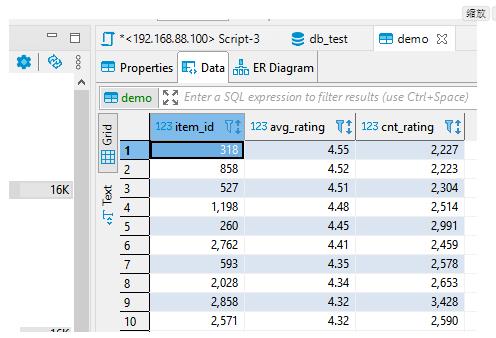Spark综合练习——电影评分数据分析
Posted Maynor996
tags:
篇首语:本文由小常识网(cha138.com)小编为大家整理,主要介绍了Spark综合练习——电影评分数据分析相关的知识,希望对你有一定的参考价值。
我正在参加年度博客之星评选,请大家帮我投票打分,您的每一分都是对我的支持与鼓励。
2021年「博客之星」参赛博主:Maynor大数据 (感谢礼品、红包免费送!)
https://bbs.csdn.net/topics/603955366

文章目录
引言
大家好,我是ChinaManor,直译过来就是中国码农的意思,俺希望自己能成为国家复兴道路的铺路人,大数据领域的耕耘者,一个平凡而不平庸的人。
全部数据:
链接:https://pan.baidu.com/s/1qiO9aRb7yQeuHDtH1cWklw 提取码:nwxj
今天给大家带来一个Spark综合练习案例–电影评分
老师:给定需求统计评分次数>200的电影平均分Top10,并写入mysql数据库中
我:所有字我都认识,怎么连在一起我就不认识了

不管了先new个实例对象,总没错吧
val sparkSession = SparkSession
.builder()
.config("spark.sql.shuffle.partitions", "4")
.appName("电影数据分析")
.master("local[2]")
.getOrCreate()
然后大数据无非输入,转换,输出,我再弄个spark读取文件?

val lines: RDD[String] = sparkSession.read.textFile("E:\\\\xx\\\\SparkDemo\\\\input\\\\ratings.dat").rdd
再然后RDD转换成DF
val rdd: RDD[(Int, Int, Int, Long)] = lines.mapPartitions item =>
item.map line =>
val strings: Array[String] = line.trim.split("::")
(strings(0).toInt, strings(1).toInt, strings(2).toInt, strings(3).toLong)
import sparkSession.implicits._
val reusltDF: DataFrame = rdd.toDF("user_id", "item_id", "rating", "timestamp")
测试一下行不行

// 查看约束
reusltDF.printSchema()
//查看数据
reusltDF.show()
好像跑通了!!笑容逐渐放肆~什么SQL不整了,上来直接DSL

val resultDS: Dataset[Row] = reusltDF
//a.对数据按电影id进行分组
.groupBy($"item_id")
//b.对聚合数据求平均值和评分次数
.agg(
round(avg($"rating"), 2).as("avg_rating"),
count($"user_id").as("cnt_rating")
)
//c.过滤出评分大于2000的
.filter($"cnt_rating" > 2000)
//d.按照评分的平均值进行降序排序
.orderBy($"avg_rating".desc)
//e.取前十条数据
.limit(10)
最后最后保存到Mysql
SaveToMysql(resultDF);
/**
* 保存数据至MySQL数据库,使用函数foreachPartition对每个分区数据操作,主键存在时更新,不存在时插入
*/
def saveToMySQL(dataFrame: DataFrame): Unit =
dataFrame.rdd.coalesce(1).foreachPartition iter =>
// a. 加载驱动类
Class.forName("com.mysql.cj.jdbc.Driver")
// 声明变量
var conn: Connection = null
var pstmt: PreparedStatement = null
try
// b. 获取连接
conn = DriverManager.getConnection(
"jdbc:mysql://192.168.88.100:3306/?serverTimezone=UTC&characterEncoding=utf8&useUnicode=true",
"root", //
"123456"
)
// c. 获取PreparedStatement对象
val insertSql ="""
|INSERT
|O
| db_test.demo
| (item_id, avg_rating, cnt_rating)
|VALUES (?, ?, ?)
|""".stripMargin
pstmt = conn.prepareStatement(insertSql)
conn.setAutoCommit(false)
// d. 将分区中数据插入到表中,批量插入
iter.foreach row =>
pstmt.setInt(1, row.getAs[Int]("item_id"))
pstmt.setInt(2, row.getAs[Int]("avg_rating"))
pstmt.setInt(3, row.getAs[Int]("cnt_rating"))
// 加入批次
pstmt.addBatch()
// TODO: 批量插入
pstmt.executeBatch()
conn.commit()
catch
case e: Exception => e.printStackTrace()
finally
if(null != pstmt) pstmt.close()
if(null != conn) conn.close()

大功告成了!

补充: 采用DSL编程的详尽注释版
package cn.itcast.spark.metrics
import java.sql.Connection, DriverManager, PreparedStatement
import org.apache.spark.sql.DataFrame, Row, SparkSession
import org.apache.spark.sql.functions._
import org.apache.spark.storage.StorageLevel
/**
* 电影评分数据分析,需求如下:
* 需求1:查找电影评分个数超过50,且平均评分较高的前十部电影名称及其对应的平均评分
* 电影ID 评分个数 电影名称 平均评分 更新时间
* movie_id、rating_num、title、rating_avg、update_time
* 需求2:查找每个电影类别及其对应的平均评分
* 电影类别 电影类别平均评分 更新时间
* genre、 rating_avg 、update_time
* 需求3:查找被评分次数较多的前十部电影
* 电影ID 电影名称 电影被评分的次数 更新时间
* movie_id、title、rating_num、 update_time
*/
object MetricsAppMain
// 文件路径
private val RATINGS_CSV_FILE_PATH = "D:\\\\Users\\\\Administrator\\\\Desktop\\\\exam0601\\\\datas\\\\ratings.csv"
private val MOVIES_CSV_FILE_PATH = "D:\\\\Users\\\\Administrator\\\\Desktop\\\\exam0601\\\\datas\\\\movies.csv"
def main(args: Array[String]): Unit =
// step1、创建SparkSession实例对象
val spark: SparkSession = createSparkSession(this.getClass)
import spark.implicits._
/*
分析需求可知,三个需求最终结果,需要使用事实表数据和维度表数据关联,所以先数据拉宽,再指标计算
TODO: 按照数据仓库分层理论管理数据和开发指标
- 第一层(最底层):ODS层
直接加CSV文件数据为DataFrame
- 第二层(中间层):DW层
将加载业务数据(电影评分数据)和维度数据(电影基本信息数据)进行Join关联,拉宽操作
- 第三层(最上层):DA层/APP层
依据需求开发程序,计算指标,进行存储到MySQL表
*/
// step2、【ODS层】:加载数据,CSV格式数据,文件首行为列名称
val ratingDF: DataFrame = readCsvFile(spark, RATINGS_CSV_FILE_PATH, verbose = false)
val movieDF: DataFrame = readCsvFile(spark, MOVIES_CSV_FILE_PATH, verbose = false)
// step3、【DW层】:将电影评分数据与电影信息数据进行关联,数据拉宽操作
val detailDF: DataFrame = joinDetail(ratingDF, movieDF)
//printConsole(detailDF)
// step4、【DA层】:按照业务需求,进行指标统计分析
computeMetric(detailDF)
Thread.sleep(1000000)
// 应用结束,关闭资源
spark.stop()
/**
* 构建SparkSession实例对象,默认情况下本地模式运行
*/
def createSparkSession(clazz: Class[_], master: String = "local[2]"): SparkSession =
SparkSession.builder()
.appName(clazz.getSimpleName.stripSuffix("$"))
.master(master)
.config("spark.sql.shuffle.partitions", "2")
.getOrCreate()
/**
* 读取CSV格式文本文件数据,封装到DataFrame数据集
*/
def readCsvFile(spark: SparkSession, path: String, verbose: Boolean = true): DataFrame =
val dataframe: DataFrame = spark.read
// 设置分隔符为逗号
.option("sep", ",")
// 文件首行为列名称
.option("header", "true")
// 依据数值自动推断数据类型
.option("inferSchema", "true")
.csv(path)
if(verbose)
printConsole(dataframe)
// 返回数据集
dataframe
/**
* 将事实表数据与维度表数据进行Join关联
*/
def joinDetail(df1: DataFrame, df2: DataFrame, joinType: String = "left_outer"): DataFrame =
df1
// 采用leftJoin关联数据
.join(df2, df1("movieId") === df2("movieId"), joinType)
// 选取字段
.select(
df1("userId").as("user_id"), //
df1("movieId").as("movie_id"), //
df1("rating"), //
df1("timestamp"), //
df2("title"), //
df2("genres") //
)
/**
* 按照业务需求,进行指标统计,默认情况下,结果数据打印控制台
*/
def computeMetric(dataframe: DataFrame): Unit =
// TODO: 缓存数据
dataframe.persist(StorageLevel.MEMORY_AND_DISK)
// 需求1:查找电影评分个数超过50,且平均评分较高的前十部电影名称及其对应的平均评分
val top10FilesDF: DataFrame = top10Films(dataframe)
//printConsole(top10FilesDF)
upsertToMySQL(
top10FilesDF, //
"replace into db_metrics.top_10_files (id, movie_id, rating_num, title, rating_avg) values (null, ?, ?, ?, ?)", //
(pstmt: PreparedStatement, row: Row) =>
pstmt.setInt(1, row.getAs[Int]("movie_id"))
pstmt.setLong(2, row.getAs[Long]("rating_num"))
pstmt.setString(3, row.getAs[String]("title"))
pstmt.setDouble(4, row.getAs[Double]("rating_avg"))
)
// 需求2:查找每个电影类别及其对应的平均评分
val genresRatingDF: DataFrame = genresRating(dataframe)
//printConsole(genresRatingDF)
// upsertToMySQL(
// genresRatingDF, //
// "replace into db_metrics.genres_rating (id, genre, rating_avg) values (null, ?, ?)", //
// (pstmt: PreparedStatement, row: Row) =>
// pstmt.setString(1, row.getAs[String]("genre"))
// pstmt.setDouble(2, row.getAs[Double]("rating_avg"))
//
// )
// 需求3:查找被评分次数较多的前十部电影
val best10FilesDF: DataFrame = best10Files(dataframe)
//printConsole(best10FilesDF)
// upsertToMySQL(
// best10FilesDF, //
// "replace into db_metrics.best_10_films (id, movie_id, title, rating_num) values (null, ?, ?, ?)", //
// (pstmt: PreparedStatement, row: Row) =>
// pstmt.setInt(1, row.getAs[Int]("movie_id"))
// pstmt.setString(2, row.getAs[String]("title"))
// pstmt.setLong(3, row.getAs[Long]("rating_num"))
//
// )
// 释放资源
dataframe.unpersist()
/**
* 需求:查找电影评分个数超过50,且平均评分较高的前十部电影名称及其对应的平均评分
* 电影ID 评分个数 电影名称 平均评分 更新时间
* movie_id、rating_num、title、rating_avg、update_time
*/
def top10Films(dataframe: DataFrame): DataFrame =
import dataframe.sparkSession.implicits._
dataframe
.groupBy($"movie_id", $"title")
.agg(
count($"movie_id").as("rating_num"), // 统计电影被评分的个数
round(avg($"rating"), 2).as("rating_avg") // 统计电影被评分的平均分
)
// 过滤评分个数大于50
.where($"rating_num" > 50)
// 降序排序,按照平均分
.orderBy($"rating_avg".desc)
// 获取前10电影
.limit(10)
// 添加日期字段
.withColumn("update_time", current_timestamp())
/**
* 需求:查找每个电影类别及其对应的平均评分
* 电影类别 电影类别平均评分 更新时间
* genre、 rating_avg 、update_time
*/
def genresRating(dataframe: DataFrame): DataFrame =
import dataframe.sparkSession.implicits._
dataframe
// 将每个电影类别字段:genres,按照|划分,使用爆炸函数进行行转列
.select(
explode(split($"genres", "\\\\|")).as("genre"), //
$"rating" //
)
// 按照类别分组,计算平均评分
.groupBy($"genre")
.agg(
round(avg($"rating"), 2).as("rating_avg")
)
// 对统计值降序排序
.orderBy($"rating_avg".desc)
// 添加日期字段
.withColumn("update_time", current_timestamp())
/**
* 需求:查找被评分次数较多的前十部电影
* 电影ID 电影名称 电影被评分的次数 更新时间
* movie_id、title、rating_num、 update_time
*/
def best10Files(dataframe: DataFrame): DataFrame =
import dataframe.sparkSession.implicits._
dataframe
.groupBy($"movie_id", $"title")
.agg(
count($"movie_id").as("rating_num") // 统计电影被评分的个数
)
// 降序排序,按照平均分
.orderBy($"rating_num".desc)
// 获取前10电影
.limit(10)
// 添加日期字段
.withColumn("update_time", current_timestamp())
/**
* 将DataFrame数据集打印控制台,显示Schema信息和前10条数据
*/
def printConsole(dataframe: DataFrame): Unit =
// 显示Schema信息
dataframe.printSchema()
// 显示前10条数据
dataframe.show(10, truncate = false)
/**
* 将数据保存至MySQL表中,采用replace方式,当主键存在时,更新数据;不存在时,插入数据
* @param dataframe 数据集
* @param sql 插入数据SQL语句
* @param accept 函数,如何设置Row中每列数据到SQL语句中占位符值
*/
def upsertToMySQL(dataframe: DataFrame, sql: String,
accept: (PreparedStatement, Row) => Unit): Unit =
// 降低分区数目,对每个分区进行操作
dataframe.coalesce(1).foreachPartitioniter =>
// step1. 加载驱动类
Class.forName("com.mysql.cj.jdbc.Driver")
// 声明变量
var conn: Connection = null
var pstmt: PreparedStatement = null
try
// step2. 创建连接
conn = DriverManager.getConnection(
"jdbc:mysql://192.168.88.100:3306/?serverTimezone=UTC&characterEncoding=utf8&useUnicode=true",
"root",
"123456"
)
pstmt = conn.prepareStatement(sql)
// step3. 插入数据
iter.foreachrow =>
// 设置SQL语句中占位符的值
accept(pstmt, row)
// 加入批次中
pstmt.addBatch()
// 批量执行批次
pstmt.executeBatch()
catch
case e: Exception => e.printStackTrace()
finally
// step4. 关闭连接
if(null != pstmt) pstmt.close()
if(null != conn) conn.close()
总结
以上便是电影评分数据分析spark版,愿你读过之后有自己的收获,如果有收获不妨一键三连一下~
以上是关于Spark综合练习——电影评分数据分析的主要内容,如果未能解决你的问题,请参考以下文章